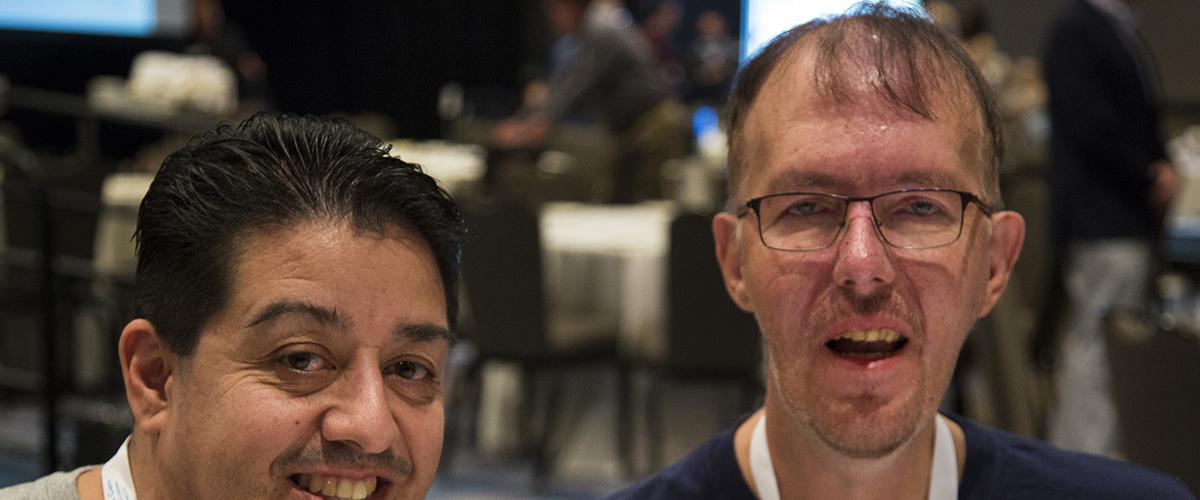
Sisters Mary Dowdle (37) and Caroline Easterling (39) live in neighboring states: Maryland and Virginia, respectively. Both women live with myotonic dystrophy type 1, as did their father, grandfather and great grandfather. Their older sister, Cassie Carroll, does not have DM, nor did any of their father’s siblings. Mary and Caroline are very active with Myotonic and play a vital role in Myotonic’s community. We spoke with them recently about their journeys and experiences with DM.
Myotonic: Can you describe your experience with DM?
Caroline: “In 1999, my dad was having serious health issues, such as muscle weakness, cataracts, GI problems, etc. His father and grandfather had been diagnosed with Parkinson’s and that’s how the doctors thought they’d died. But then my father found out he had DM.
“As a teenager, I had myotonia in my hands. My doctor diagnosed me with sclerosis and told me I’d be fine. In 2000, I was diagnosed with DM. I had been searching for information, but it was a challenge to find someone who knew anything about DM. After my father was diagnosed, the whole family entered into a clinical study, genetics counseling and a longitudinal study.”
Myotonic: How has the disease progressed since then?
Caroline: “Since the diagnosis the myotonia has gotten worse. I have a lot of weakness in my ankles, hands, and muscles. I used to be very active. I’ve been trying to work with a trainer to maintain muscle strength.
I know that parents can pass on the congenital form of DM so when my husband and I decided to have children, we opted for IVF and had only the healthy eggs implanted. After three cycles of IVF, we ended up with twins who are healthy. All my doctors said I shouldn’t carry twins, but I wanted to. They were both born by Cesarean section at 32 weeks, and they don’t have the genetic mutation. I was lucky because the National Institutes of Health (NIH) put me in touch with the right doctors who could do IVF and carry out the right tests.”
Myotonic: Can you tell us about your journey, Mary?
Mary: “I’m the youngest of three girls. I didn’t think to get tested when my sisters were diagnosed. It wasn’t until 2011 that I got tested, and it was only because of a clinical study in Rochester that my family participated in, for which a blood test was required. My priorities were different in 2000. I was in high school, then college, and I was living my life. I was able to function normally and didn’t really want to know what was wrong, so I didn’t get tested until a couple of years ago. There was definitely some denial there.”
Myotonic: Were you experiencing symptoms?
Mary: “I started experiencing symptoms around age 18. GI pain was and is the biggest issue. I experience it every day, and it’s constant. It’s been debilitating. Before I was tested and diagnosed, the doctors thought my appendix was the problem, so it was taken out. I’ve also had two colonoscopies. After dozens of tests, they still didn’t know what was wrong. The hardest thing about this is that, after 19 years, none of our family doctors are knowledgeable about DM. Treatment options are very limited. They can make accommodations, but there is no cure.”
Myotonic: How has each of your experiences with DM affected the other?
Caroline: Mary and I have always been very close. I was very involved with my dad’s health progression, so I tried to help Mary by bringing her into the process of discovery and research. I visit the NIH every year and get tested. NIH and Myotonic are invaluable resources for me, both medically speaking and in terms of support and information. And I try to pass that on to Mary.”
Mary: Caroline has always been very supportive and answered a lot of my questions. She has helped me with the kind of questions you don’t want to ask your doctor. It’s great to have someone to talk to who knows what you’re going through. You can’t really talk to someone who doesn’t understand or know what you’re experiencing in the same way you can with someone who does. My older sister and I are close but I can’t talk to her about the issues I’m having. Caroline and I don’t have the same symptoms right now but we may have similar symptoms in the future. So in terms of treatment options, we can offer each other information and support.”

